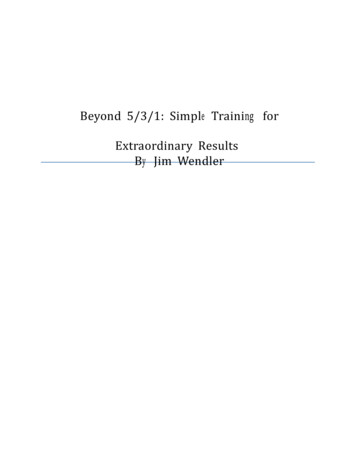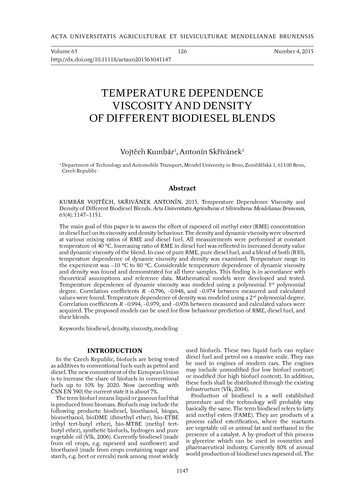
Transcription
Delivering Extraordinary Density for Cloud Service Providers –Parallels Shared Hosting NG Service Moduleand Intel Xeon 5500 Processor Series-Based ServersAbstract: The goal of this paper is to provide detail on how to best deploy highly efficient, next generationShared Web Services to enable Cloud Service Providers to deploy a more scalable and resilient Intelinfrastructure, while at the same time delivering higher service levels at lower costs.
Table of Contents1. KEY FACTORS IN SHARED WEB HOSTING DEPLOYMENTS . . 32. SHARED WEB HOSTING IN THE PUBLIC CLOUD MARKET . . 43. SHARED WEB HOSTING NG ARCHITECTURE . . 64. SHARED WEB HOSTING INTEL TEST BED . . 95. CHARACTERIZING SHARED WEB HOSTING WORKLOADS . . 106. LINUX SHARED HOSTING NG WORKLOAD RESULTS . . 127. BENEFIT TO CLOUD SERVICE PROVIDERS . 14 2010 Parallels. All Rights Reserved.2
1. KEY FACTORS IN SHARED WEB HOSTING DEPLOYMENTSThe Need for the Next Generation of Web HostingShared Hosting has become a commodity. Many cloud service providers offer it as an entry level serviceto up-sell other offerings. Shared Web Hosting has low differentiation between providers and the marginsassociated with it are also low. Meanwhile, end users expect these commodity services to have thesame high availability as their email service. The more added value services customers consume, thehigher their expectations are that Shared Web Hosting should be highly available and reliable, even ifthey pay virtually nothing for the service.In an effort to grow their customer base, large cloud service providers, like Google or Microsoft or otherMass Market Hosters, use their economies of scale to offer entry level Shared Web Hosting at verylow prices. They can then offer additional feature rich services like business class email and unifiedcommunications, as such value added services bring much richer profit margins.The goal of this paper is to enable cloud service providers at any level to be able to deploy a morescalable and resilient Shared Web Hosting infrastructure, while at the same time delivering higher servicelevels at lower costs.The Challenge of Cloud Service ProvidersIn order to meet the high expectations of Shared Web Hosting end users, cloud service providers needto be extremely efficient in how they offer Shared Web Hosting in order to make it a profitable service.Based on Parallels experience, there are five things a cloud services provider can do to increase theefficiency of Shared Web Hosting: Lower costs by increasing the density of sites per server Increase average revenue per user by offering more reliable and available Shared Hosting service and/or up-sell the customer to purchase additional services such as Hosted Exchange Improve service level management and segregate customers by usage or service plans across theserver farm Increase predictability of capacity planning for the service and understand the relationship of capacityto service level performance Automate the user experience and empower the end userLower Costs by Increasing the Density of Websites per ServerIncreasing the density of sites per shared hosting server can be difficult to accomplish. Applicationlimitations, lack of isolation, CPU performance, memory capacity, server storage, and server I/O capacityare common limitations. Shared Web Hosting server farms must be carefully optimized to maximizethe number of site per server while, at the same time, achieving the required performance levels. Lackof redundancy, however, increases the potential for service outages as server or networking failuresoccur more frequently in low-end servers that do not offer high reliability components. If density plusredundancy can be achieved, datacenter cost savings can be realized.Increase Average Revenue per User by Offering Other ServicesA common sales strategy for shared hosting is to get a large base of customers and then sell additionalservices to increase the average revenue per user. Common additional services include domain names,web site builder applications, SSL certificates, business class Email services, and Software as a Service.Shared Hosting plans are generally separated by commodity resources like storage and Internetbandwidth. 2010 Parallels. All Rights Reserved.3
Improve Service Level ManagementShared Web Hosting service levels are generally based on a best effort basis. Cloud service providersdo their best to have high system availability, but they do not offer guaranteed Service Level Agreementsand/or the means to measure service availability to compensate end users should an outage occur.Since there is no SLA, heavy service users can consume more than their fair share of resources, whichimpacts other users and increases the potential of service churn due to a poor experience.Increase Predictability of Capacity and Availability PlanningManaging the Shared Web Hosting service availability and capacity is also very important in providing apositive customer experience. Service growth over time is generally very predictable and cloud serviceproviders who monitor their capacity usage can predict when additional resources will be required suchas additional servers, storage capacity or network switches. Cloud service providers who do not activelymonitor service resource consumption may realize too late that additional resources are needed, and thiscan create poor performance for weeks until additional resources can be added.Automate the User Experience and Empower the End UserAutomating the user experience is extremely important as end users expect cloud services to be ondemand. End users want to be in control of their account and expect to have the ability to control servicefeatures directly via a control panel and not have to open a trouble ticket or place a call to the cloudservices provider. The margins are very thin with Shared Web Hosting services and a single support callcan eliminate the margins associated with that account for an entire year.Parallels Operations Automation Linux Shared Hosting NG Module addresses these five keyareas, enabling cloud service providers who supply Shared Web Services to operate a higher density,more efficient and available service. While only in beta at the present time, this white paper will explorebest practices for deploying the Linux Shared Hosting NG Service Module solution on Intel Xeon 5500processor series-based servers, including an architectural overview, test-bed hardware requirements,workload characterization, and the test-bed performance results obtained.2. SHARED WEB HOSTING IN THE PUBLIC CLOUD MARKETShared Web Hosting – BackgroundShared web hosting service or virtual hosting service refers to a web hosting service where manywebsites reside on one web server connected to the Internet. Each site “sits” on its own partition, orsection on the server to keep it separate from other sites. This is generally the most economical optionfor hosting, as many people share the overall cost of server maintenance.The hosting service must include system administration since it is shared by many users; this is a benefitfor users who do not want to deal with admin functions, but a hindrance to power users who wantmore control. In general shared hosting will be inappropriate for users who require extensive softwaredevelopment outside what the hosting provider supports. Almost all applications intended to be on astandard web server work fine with a shared web hosting service. Shared hosting usually has usagelimits and most hosting providers do not have extensive reliability features in place. Shared hostingtypically offers a web-based control panel system, such as the Parallels Plesk Panel product suite, asan added value service. In shared hosting, the provider is generally responsible for managing servers,installing server software, security updates, technical support, and other aspects of the service. It istypically based on the LAMP stack. This is driven by the low cost of open source software, though someproviders offer Microsoft Windows-based solutions. The initial release of Parallels Linux Shared HostingNG Service Module is focused on LAMP based websites. 2010 Parallels. All Rights Reserved.4
The current approach for Parallels Shared Web Hosting is depicted in the following diagram, where thewebsite data is stored directly on web servers and there are no load balancers to control the assignmentwebsites to web servers. If a web server fails, all websites assigned to that server must be restarted.With 1000 to 2000 websites per server, this can take 20 to 30 minutes.3. SHARED WEB HOSTING NG ARCHITECTURELinux Shared Hosting NG Service Module – Main ComponentsThe main components consist of Load Balancers, Linux Web Servers (with Apache), Linux DatabaseServers (with MySQL or PostgreSQL), and a NFS Share Storage Server. The diagram below details thearchitectural flow.Load Balancers Required for High Availability, Dynamic Load Redistribution and Seamless Capacity Management Any load balancing devices that provide direct routing and sticky sessions are supported as well Most service providers are expected to deploy hardware load balancers Linux LVS is used in the Linux Shared Hosting NG Service Module test-bed as it is an easy toconfigure, cost-effective solution for testing purposes 2010 Parallels. All Rights Reserved.5
Web Servers Every web-server can process requests for any site Apache was chosen to utilize its specific features (.htaccess ) widely used in existing websites andrequired for seamless migration Web-Servers also handle FTP and SSH connectionsDatabase Servers Customers MySQL or PostgreSQL databases are handled by separate serversNFS Shared Storage Server NFS3 file systems are used to store sites content All file systems are mounted to all web servers Configuration DatabaseConfiguration of all sites handled by web cluster system are stored in a Central ConfigurationDatabase on the NFS Shared Storage ServerSHNG Cluster ComponentsInternetHTTP(s)RequestsLoad NG NSSplugin.sshdSHNG B ver 1Web-Server NSitesí configuration (SQL)File system1File systemmSitesí content(NFS3)Conf. DBReplicaConf. DB.NFS Shared Storage 2010 Parallels. All Rights Reserved.Configuration Database6
Linux Shared Hosting NG – Implementation DetailsParallels and Intel engineers built a test-bed based on Intel Xeon 5500 Processor Series-based servers.The key implementation details for the Linux Shared Hosting NG Service Module on the Intel test-bedinclude a set of functions that are diagramed by the web requests processing flow.Load Balancer and Shared IPs Sites are grouped by IP, about 1000 sites per IP Direct routing is used – any web server can answer requests for any IP Sticky sessions are used for effective cachingWebsite Isolation Dynamic content requests are processed through on demand standalone “cgig processes” that forkand create for each site an Parallels Containers-based Light Weight Environment (LVE) LVE context is limited by CPU, RAM, user UID and GID All dynamic requests to one site come to the same LVE and share CPU and RAM limits LVE is removed by kernel once all processes for a given site are finished Static content requests are processed by Apache Request rates and bandwidth are throttled in Apache All limits are stored per site in central configuration databaseConfiguration Database and Caching Service The Linux Shared Hosting NG Service Module Caching Service is used to retrieve sites configurationdata; this service caches data in RAM, and cached entries are removed if they are changed inConfiguration Database The Linux Shared Hosting NG Service Module Caching Service automatically switches to a replicaserver if the main Configuration Database is inaccessibleNFS3 Shared Storage andContent CachingHTTP(s) Requests Processing Diagram Standard Linux kernel NFSfile system cache is used toimprove performanceInternetHTTP(s)RequestsWeb Server Log WritingThrough the Linux SharedHosting NG Module Web Server Site Logs arestored in a “site contentdirectory” on the SharedStorage Server Site Log writing is buffered inthe Linux Shared Hosting NGService Module; there is onecommon buffer for all siteshandled by one server, which isflushed to disk once every 10seconds or if the size reaches16MBIP1.IPnLoad t].cgid1.c[root]SHNGModuleLVE (site-id)[uid, gid]SHNGCachingServiceLVE (site-id)[uid, gid]SHNGCachingServiceWeb-Server 1IP1.IPnFile systemmFile system1Sitesí content(NFS3)Web-Server NIP1.IPnConf. DBReplicaConf. DB.NFS Shared Storage 2010 Parallels. All Rights Reserved.DynamicRequestsApacheConfiguration Database7
Shared Hosting NG – Cloud Linux ArchitectureTo achieve isolation and granular control of individual websites, the Parallels Linux Shared Hosting NGModule will be implemented on a new Linux offering based on CentOS. Called Cloud Linux, this newvariant will offer lightweight virtual environments (LVEs) to control CPU and RAM allocations on a perwebsite basis. The LVE technology is based on Parallels Virtuozzo Containers.The key differences between a standard Linux OS and Cloud Linux are detailed in the diagram below.Standard Linux OS (e.g. CentOS)Cloud Linux Standard OS Multiple web sites per server Resource isolation via lightweight virtualenvironment (LVE) Any web site can drain resources for avariety of reasons Prevents individual web sites from using toomuch resources Single website can overload the server Single website cannot overload the server Increases risk and lowers efficiency ofserver Lowers risk, increases efficiency andimproves server performanceWeb sitesWeb sitesStandard Linux Host OSCloud LinuxHardwareHardwareIn a standard Linux OS kernel there is no ability to provide for resource control. This shared resourcepool approach leads to websites which can over-consume precious compute and memory resources,impacting the performance of every website on a given server.With Parallels Lightweight Virtual Environments, websites on Cloud Linux will be able to apply CPU andmemory limits on a per site basis (as noted by the dotted red lines in the diagram above). The ParallelsLinux Shared Hosting NG Service Module will enable dynamic adjustment of service levels, allowing acustomer to change their service plan to guarantee more resources if they find their website is sluggishand requires a higher level of performance. 2010 Parallels. All Rights Reserved.8
4. SHARED WEB HOSTING INTEL TEST BEDThe Shared Web Hosting test bed is comprised of Load Balancers, Web Servers, Shared Storage,and Parallels Operations Automation management server. The diagram below details the overall logicallayout.The physical layout of the Linux Shared Hosting NG Service Module test bed consists of 16 Nehalembased EP Servers (Xeon X5570 dual socket/16GB RAM/500GB Local Disk) with CentOS 5.4 x86 64;Niantic 10GbE NICs were used for internal connections. 2010 Parallels. All Rights Reserved.9
NFS storage was configured using an Intel Timber Creek Dual CPU Storage Server with 8 GB memory,12 SATA 1TB disk, RAID controller and Open-E NAS Storage software. Each server was also connectedto 1GbE switch for management interface (not mentioned on diagram).A second test bed was created to compare the performance improvements found in Intel Xeon 55xxservers over Intel Xeon 54xx based servers (shown as al01-al03 on the diagram above) configured with2xIntel Xeon E5450 processors @ 3GHz, 8GB of RAM, 250GB SATA HDD. This second cluster sharessame MySQL servers, NFS storage, Load Balancer, and HTTP clients.5. CHARACTERIZING SHARED WEB HOSTING WORKLOADSTo determine the optimal number of websites which can be supported on Intel Xeon 5500 processorseries (dual socket) servers, the Parallels Linux Shared Hosting NG Service Module engineering teaminvestigated web server logs from more than 20 web different servers dedicated to Shared Web Hosting.This data revealed the following key data points: 1% of website sites generate 60% of the total load on a given web serverRequests Distribution by SitesRequests Distribution by SitesPercent of all requests100%Percent of all requests100%50%50%0%Percent of sites1%2%3%4%5%6%7%8%9%10%Percent of sites0%1%2%3%4%5%6%7%8%9%10% 85% of HTTP requests are for static content (static HTML pages, picture, etc.) 15% of requests are for dynamic content (mostly PHP scripts)Requests Distribution by TypeRequests Distribution by Type15.00%Static content15.00%85.00%85.00%DynamiccontentStatic contentDynamic contentWeb Applications Usage 2010 Parallels. All Rights Reserved.10Web Applications Usage
Wordpress, joomla and phpBB represent the majority of dynamic requestsWeb Applications llery2.79%Understanding the workload mix of typical Shared Hosting web servers is the first step to determiningthe number of websites which can be supported per server. The next step is to analyze the number ofrequests generated per web application type.It was determined that: Average request rate is approximately 50 requests per second for 10K sites and 100 requestsper second at peak moments The following diagram details number requests per second over a 6 day period120.0100.080.060.040.0Static (r/s)Other dynamic (r/s)Wordpress (r/s)Joomla :006:0012:0018:000:006:0012:0018:000.0Based on statistics above, the Parallels Linux Shared Hosting NG Service Module team preparedbenchmark system consisting of Set of scripts which use httperf to measure web servers performance A generic average website for benchmarking Shared Web Hosting solutions 2010 Parallels. All Rights Reserved.11
Benchmark scripts take into account typical requests distribution between sites, requests distributionbetween dynamic/static content, and requests distribution between applications. Two models wereselected, which differ only by distribution between web applications used:"Heavy" model"Light" modelWordpress - 30%phpBB - 33%Joomla - 10%vBulletin - 33%phpBB - 60%eScene - 33%These graphs represent a model which is very close to the real life scenario found in the web server logsfrom the site data analyzed from leading web hosting providers.6. LINUX SHARED HOSTING NG WORKLOAD RESULTSIntel XEON 5570 CLUSTER – PURE PERFORMANCENehalem-based Test Configuration 7 web-servers (SHNGb1-SHNGb7) 2 x Intel Xeon 5570 CPUs, 16 GB RAM each 100,000 sites on IPs 10.22.1.100 – 10.22.1.199 1000 sites per one IP Each site contains several static pages, Wordpress, Joomla and phpBB 1 Load Balancer node (SHNGb10) 4 MySQL servers for site’s databases (SHNGb10, SHNGs4, SHNGs5, SHNGs6) 2 x Intel Xeon 5570 CPUs, 16 GB RAM each 4 servers are used as HTTP clients (SHNGs* and SHNGb8)During the test, cluster load was incrementally increased at every 20 seconds measurement period,where the error or time out (4 seconds) was less than 0.1% from all current period requests. 2010 Parallels. All Rights Reserved.12
Test resultsIn the Heavy Model with the Intel Xeon processor 5500 series servers, the connection response andreply times are key in we
Based on Parallels experience, there are five things a Cloud Services Provider can do to increase the efficiency of Shared Web Hosting: Lower costs by increasing the density of sites per server Increase average revenue per user by offerin











